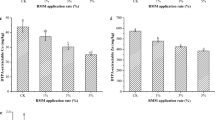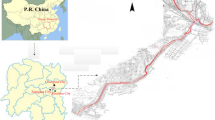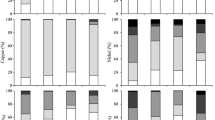Abstract
The aim of this study is to assess the effectiveness of sea sand (SS), crushed concrete (CC), and bentonite (BN) as a capping material to block the release of trace metals (As, Cd, Cr, Cu, Ni, Pb, and Zn) from heavily contaminated marine sediments, and to stabilize/solidify these trace metals in the sediments. The efficiency of SS, CC, and BN for blocking trace metals was evaluated in a flat flow tank in which a 1-cm-thick layer of capping materials was placed above the contaminated sediments. Trace metals were released into the overlying water from contaminated sediments in the following decreasing order: Cd > As > Zn > Ni > Pb > Cr > Cu. Electronegativity, electrostatic force, or metal hydrolysis significantly influenced the mobility of trace metals in sediments. The elution of Cu, Ni, and Cd from contaminated sediments was effectively reduced by CC, especially in case of Cd elution. SS was appropriate for interrupting Cr and Zn release, and BN was appropriate for interrupting Pb release. A sequential extraction study demonstrated that SS capping is appropriate for stabilizing As, Cu, and Ni; CC capping for Zn; and BN capping for Pb. SS, CC, and BN can be applied effectively for remediating the contaminated sediments.




Similar content being viewed by others
References
Abollino, O., Aceto, M., Malandrino, M., Sarzanini, C., & Mentasti, E. (2003). Adsorption of heavy metals on Na-montmorillonite. Effect of pH and organic substances. Water Research, 37, 1619–1627.
Alloway, B. J. (1995). Chapter 2. Soil processes and the behavior of heavy metals. In B. J. Alloway (Ed.), Heavy metals in soils (2nd ed.). London: Blackie Academic and Professional.
Basta, N. T., & McGowen, S. L. (2004). Evaluation of chemical immobilization treatments for reducing heavy metal transport in a smelter-contaminated soil. Environmental Pollution, 127, 73–82.
Batchelor, B. (1998). Leach models for contaminants immobilized by pH-dependent mechanisms. Environmental Science and Technology, 32, 1721–1726.
Brummer, G. W. (1986). Heavy metal species mobility and availability in soil. In M. Bernhard, F. E. Brinckman, & P. J. Sadler (Eds.), The importance of chemical speciation in environmental processes. Berlin: Springer-Verlag.
Coleman, N. J., Lee, W. E., & Slipper, I. J. (2005). Interactions of aqueous Cu2+, Zn2+ and Pb2+ ions with crushed concrete fines. Journal of Hazardous Materials, 121, 203–213.
Eek, E., Godøy, O., Aagaard, P., & Breedveld, G. D. (2007). Experimental determination of efficiency of capping materials during consolidation of metal-contaminated dredged material. Chemosphere, 69, 719–728.
Föstner, U., & Apitz, S. E. (2007). Sediment remediation: U.S. focus on capping and monitored natural recovery. Fourth International Battelle Conference on Remediation of Contaminated Sediments. Fourth International Battelle.
Gray, C. W., Dunham, S. J., Dennis, P. G., Zhao, F. J., & McGrath, S. P. (2006). Field evaluation of in situ remediation of a heavy metal contaminated soil using lime and red-mud. Environmental Pollution, 142, 530–539.
Hickey, M. G., & Kittrick, J. A. (1984). Chemical partitioning of cadmium, copper, nickel and zinc in soils and sediments containing high levels of heavy metals. Journal of Environmental Quality, 13, 372–376.
Huang, T., Xu, J., & Cai, D. (2011). Efficiency of active barriers attaching biofilm as sediment capping to eliminate the internal nitrogen in eutrophic lake and canal. Journal of Environmental Sciences, 23, 738–743.
Hull, J. H., Jersak, J. M., & Kasper, C. A. (1999). In situ capping of contaminated sediments: comparing the relative effectiveness of sand versus clay mineral-based sediment caps. Proceedings of the 1999 Conference on Hazardous Waste.
Jacobs, P. H., & Förstner, U. (1999). Concept of subaqueous capping of contaminated sediments with active barrier systems (ABS) using natural and modified zeolites. Water Research, 33, 2083–2087.
Knox, A. S., Kaplan, D. I., Adriano, D. C., Hinton, T. G., & Wilson, M. D. (2003). Apatite and phillipsite as sequestering agents for metals and radionuclides. Journal of Environmental Quality, 32, 515–525.
Knox, A. S., Kaplan, D. I., & Paller, M. H. (2006). Natural phosphate sources and their suitability for remediation of contaminated media. Science of the Total Environment, 357, 271–279.
Knox, A. S., Paller, M. H., Reible, D. D., Ma, X., & Petrisor, I. G. (2008). Sequestering agents for active caps—remediation of metals and organics. Soil and Sediment Contamination, 17, 516–532.
Lin, J., Zhan, Y., & Zhu, Z. (2011). Evaluation of sediment capping with active barrier systems (ABS) using calcite/zeolite mixtures to simultaneously manage phosphorus and ammonium release. Science of the Total Environment, 409, 638–646.
Long, E. R., MacDonald, D. D., Smith, S. L., & Calder, F. D. (1995). Incidence of adverse biological effects within ranges of chemical concentrations in marine and estuarine sediments. Environmental Management, 19, 81–97.
McBride, M. B. (1994). Environmental chemistry of soils. New York: Oxford University Press.
McCready, S., Birch, G. F., & Long, E. R. (2006). Metallic and organic contaminants in sediments of Sydney Harbour, Australia and vicinity—a chemical dataset for evaluating sediment quality guidelines. Environment International, 32, 455–465.
Mulligan, C. N., Yong, R. N., & Gibbs, B. F. (2001). Remediation technologies for metal contaminated soils and groundwater: an evaluation. Engineering Geology, 60, 193–207.
Murphy, P., Marquette, A., Reible, D., & Lowry, G. V. (2006). Predicting the performance of activated carbon-, coke-, and soil-amended thin layer sediment caps. Journal of Environmental Engineering, 132, 787–794.
Nayar, S., Goh, B., & Chou, L. (2004). Environmental impact of heavy metals from dredged and resuspended sediments on phytoplankton and bacteria assessed in in situ mesocosms. Ecotoxicology and Environmental Safety, 59, 349–369.
Perelo, L. W. (2010). Review: in situ and bioremediation of organic pollutants in aquatic sediments. Journal of Hazardous Materials, 177, 81–89.
Shi, T., Jia, S., Chen, Y., Wen, Y., Du, C., Guo, H., & Wang, Z. (2009). Adsorption of Pb(II), Cr(III), Cu(II), Cd(II) and Ni(II) onto a vanadium mine tailing from aqueous solution. Journal of Hazardous Materials, 169, 838–846.
Singh, S. P., Tack, F. M., & Verloo, M. G. (1998). Heavy metal fractionation and extractability in dredged sediment derived surface soils. Water, Air, and Soil Pollution, 102, 313–328.
Sparks, D. L. (1995). Chapter 5. Sorption phenomena on soils (Environmental soil chemistry). London: Academic Press, Inc.
Stephens, S. R., Alloway, B. J., Carter, J. E., & Parker, A. (2001). Towards the characterisation of heavy metals in dredged canal sediments and an appreciation of ‘availability’: two examples from the UK. Environmental Pollution, 113, 395–401.
Sun, H., Xu, X., Gao, G., Zhang, Z., & Yin, P. (2010). A novel integrated active capping technique for the remediation of nitrobenzene-contaminated sediment. Journal of Hazardous Materials, 182, 184–190.
Tessier, A., Campbell, P. G., & Bisson, M. (1979). Sequential extraction procedure for the speciation of particulate trace metals. Analytical Chemistry, 51, 844–851.
Wang, X. Q., Thibodeaux, L. J., Valsaraj, K. T., & Reible, D. D. (1991). Efficiency of capping contaminated bed sediments in situ. 1. Laboratory-scale experiments on diffusion-adsorption in the capping layer. Environmental Science and Technology, 25, 1578–1584.
Wang, Q., Li, Y., Wang, C., Wu, Y., & Wang, P. (2014). Development of a novel multi-functional active membrane capping barrier for the remediation of nitrobenzene-contaminated sediment. Journal of Hazardous Materials, 276, 415–421.
Welp, G., & Brümmer, G. W. (1999). Adsorption and solubility of ten metals in soil samples of different composition. Journal of Plant Nutrition and Soil Science, 162, 155–161.
Yin, K., Viana, P., Zhao, X., & Rockne, K. (2010). Characterization, performance modeling, and design of an active capping remediation project in a heavily polluted urban channel. Science of the Total Environment, 408, 3454–3463.
Yin, H., Kong, M., & Fan, C. (2013). Batch investigations on P immobilization from wastewaters and sediment using natural calcium rich sepiolite as a reactive material. Water Research, 47, 4247–4258.
Zimmerman, J. R., Ghosh, U., Millward, R. N., Bridges, T. S., & Luthy, R. G. (2004). Addition of carbon sorbents to reduce PCB and PAH bioavailability in marine sediments: physicochemical tests. Environmental Science and Technology, 38, 5458–5464.
Acknowledgments
This work was supported by the project entitled “Development of Sustainable Remediation Technology for Marine Contaminated Sediments” funded by the Korean Ministry of Oceans and Fisheries, Grant No. 20110110.
Author information
Authors and Affiliations
Corresponding author
Electronic Supplementary Material
Below is the link to the electronic supplementary material.
ESM 1
(DOCX 507 kb)
Rights and permissions
About this article
Cite this article
Kang, K., Lee, CG., Choi, JW. et al. Evaluation of the Use of Sea Sand, Crushed Concrete, and Bentonite to Stabilize Trace Metals and to Interrupt Their Release from Contaminated Marine Sediments. Water Air Soil Pollut 227, 308 (2016). https://doi.org/10.1007/s11270-016-3028-3
Received:
Accepted:
Published:
DOI: https://doi.org/10.1007/s11270-016-3028-3




